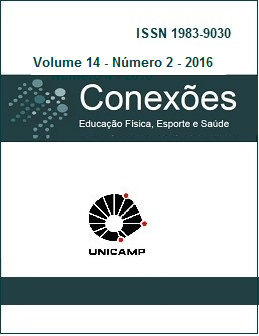Abstract
In the year 2012 the International Tennis Federation changed the children’s competitive model of tennis,
splitting into three aged categories: “8 and under”, “9 years old” and “10 years old”. Each category now has
specific adjustments when compared to the previous competitive model. Thus, this study tries to answer the
following question: Are the adjustments made for the children’s competitive model of tennis according to the
goals of formation of the technical and tactical basic fundaments of tennis? Eleven tennis coaches (seven
women and four men) from clubs and academies from Porto Alegre, RS – Brazil were interviewed. All of them
had experience in coaching tennis for children. The results indicate a relevant improvement on the development of the tennis’ technical and tactical basic fundaments when compared to the previous competitive model. However, some adjustments are suggested by the coaches, especially for the “8 and under” and “10 years old” categories.
References
FUENTES GARCIA, Jean Pedro; MENAYO ANTÚNEZ, Ruperto. Golpes del tenis: de la iniciación al alto rendimiento. Sevilla: Wanceulen, 2009.
ELDERTON, Wayne. Situation training: key to training in a game-based approach. ITF Coaching and Sport Science Review, London, v. 16, n. 44, p. 24-25, 2008.
MARQUES, Antonio. Fazer da competição dos mais jovens um modelo de formação e educação. In: GAYA, Adroaldo; MARQUES, António; TANI, Go (Org.). Desporto para crianças e jovens: razões e finalidades. Porto Alegre, Ed. da UFRGS, 2004. p. 75-96.
BUNKER, David; THORPE, Rod. The curriculum model. In: BUNKER, David; THORPE, Rod; ALMOND, Len. (Ed.). Rethinking games teaching. Loughborough: University of Technology, 1986. p. 7-10. Disponível em: http://web.uvic.ca/~thopper/tactic/Model/CURRICULUMMODEL.pdf. Acesso em: 25 maio 2015.
CRESPO, Miguel; UNIERZYSKI, Piotr. Review of modern teaching methods for tennis. Revista Internacional de Ciencias del Deporte, v. 7, n. 3, p. 1-10, 2007. Disponível em: http://www.cafyd.com/REVISTA/00701.pdf.
CORTELA, Caio Correa et al. Iniciação esportiva ao tênis de campo: um retrato do programa play and stay à luz da pedagogia do esporte. Conexões, Campinas, v. 10, n. 2, p. 214-234, maio/ago. 2012.
CÔTÉ, Jean; BAKER, Joseph; ABERNETHY, Bruce. Practice and play in the development of sport expertise. In: TENENBAUM, Gerson; EKLUND, Robert C. (Ed.). Handbook of sport psychology. 3. ed. Hoboken: Wiley, 2007. p. 184-202.
MILISTETD, Michel et al. Análise da organização competitiva de crianças e jovens: adaptações estruturais e funcionais. Revista Brasileira de Ciências do Esporte, v. 36, n. 3, p. 671-678, 2014.
INTERNATIONAL TENNIS FEDERATION (ITF). A guide to tennis 10’s. 2012. 6p.
FLICK, Uwe. Introdução à pesquisa qualitativa. 3. ed. Porto Alegre: Artmed, 2009.
ERICSSON, K. Anders. The influence of experience and deliberate practice on the development of superior expert performance. In: ERICSSON, K. Anders et al. The Cambridge handbook of expertise and expert performance. Cambridge: Cambridge University, 2006. p. 685-705.
CASSEPP-BORGES, Vicente; BALBINOTTI, Marcus A. A.; TEODORO, Maycoln L. M. Tradução e validação de conteúdo: uma proposta para a adaptação de instrumentos. In: PASQUALI, Luís (Org.). Instrumentação psicológica: fundamentos e prática. Porto Alegre: Artmed, 2010. p. 506-520.
PAY + STAY: SERVE – RALLY – SCORE. Disponível em: http://www.tennisplayandstay.com/home.aspx.
TENIS INTEGRADO. Disponível em: http://www.tenisintegrado.com.br/clube/index.
DUARTE, Rosália. Pesquisa qualitativa: reflexões sobre o trabalho de campo. Cadernos de Pesquisa, São Paulo, n.115, p. 139-154, 2002.
BARDIN, Laurence. Análise de conteúdo. 6. ed. Lisboa: Edições 70, 2011.
MILLEY, Dave. Tennis: play and stay. ITF Coaches Review, v. 42, p. 2-3, 2007.
MILLEY, Dave. Serve rally and score. The ITF tennis play and stay campaign and tennis 10’s. ITF Coaches Review, v. 51, p. 3-5, 2010.
NEWMAN, James. Why slower balls and smaller courts for 10 and under players? ITF Coaches Review, v. 51, p. 5-7, 2010.
INTERNATIONAL TENNIS FEDERATION (ITF). Manual tennis 10’s. 2010. 89p.
MARTENS, Stephen; De VYLDER, Max. The use of low compression balls in the development of high performance players. ITF Coaches Review, v. 42, p.3-5, 2007.
GALLAHUE, David L.; DONNELLY, Frances Cleland. Educação física desenvolvimentista para todas as crianças. 4. ed. São Paulo: Phorte, 2008.
PAPALIA, Diane E.; OLDS, Sally Wendkos; FELDMAN, Ruth Duskin. Desenvolvimento humano. 10. ed. São Paulo: McGraw-Hill, 2009.
BEE, Helen L.; BOYD, Denise. A criança em desenvolvimento. 12. ed. Porto Alegre: Artmed, 2011.
CORTELA, Caio Correa et al. Tenistas top 100: um estudo sobre as idades de passagens pelos diferentes marcos da carreira desportiva. Pensar a Prática, Goiânia, v. 13, n. 3, p. 1-17, 2010.
TENNIS CANADA. Long term athlete development plan for the sport of tennis in Canada. Canadá. 2011. Disponível em: https://www.tenniscanada.com/wp-content/uploads/2015/01/LTADallenglish.pdf. Acesso em: 28 abr. 2011.
FARROW, Damian; REID. Machar. The effect of equipment scaling on the skill acquisition of beginning tennis players. Journal of Sports Sciences, London, v. 28, n. 7, p. 723 -732, 2010.
KRÖGER, Christian; ROTH, Klaus. Escola da bola: um ABC para iniciantes nos jogos esportivos. 2. ed. São Paulo: Phorte, 2005.
TENNANT, Mark. Red to orange… what does it really mean? ITF Coaching and Sport Science Review, v. 18, n. 52, p. 3-4, 2010.
CRESPO, Miguel; MILEY, Dave. Manual para entrenadores avanzados. Londres: International Tennis Federation (ITF), 1999.
TENNIS. Athlete development matrix. 2008. Disponível em: http://www.tennis.com.au/pages/default.aspx?id=4&pageId=12687. Acesso em: 25 abr. 2008.
TENNANT, Mark. Appropriate competition for mini tennis. ITF Coaching and Sport Science Review, v. 10, n. 28, p. 10-11, 2002.
SILVA, S. Tênis para crianças: manual para pais, filhos e mestres. São Paulo: Via Lattera, 2003.
KLERING, Roberto Tierling. A formação do tenista de alto rendimento: o desafio entre as técnicas avançadas e os modelos estratégico-táticos. 2015. 43 f. Trabalho de Conclusão de Curso (Graduação) – Universidade Federal do Rio Grande do Sul, Porto Alegre, Rio Grande do Sul, 2015.
HAMMOND, John; SMITH. Christina. Low compression tennis balls and skill development. Journal of Sports Science and Medicine, Turquia, v. 5, p. 575-581, 2006.
LARSON, Emma J.; GUGGENHEIMER, Joshua D. The effects of scaling tennis equipment on the forehand groundstroke performance of children. Journal of Sports Science and Medicine, Turquia, v.12, 323-331, 2013.
The Conexões: Educação Física, Esporte e Saúde Journal uses the license of Creative Commons (CC), thus preserving the integrity of articles in an open access environment.


